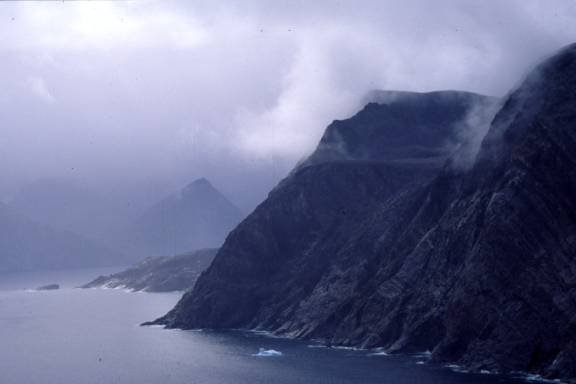Komaktorvik Ramblings
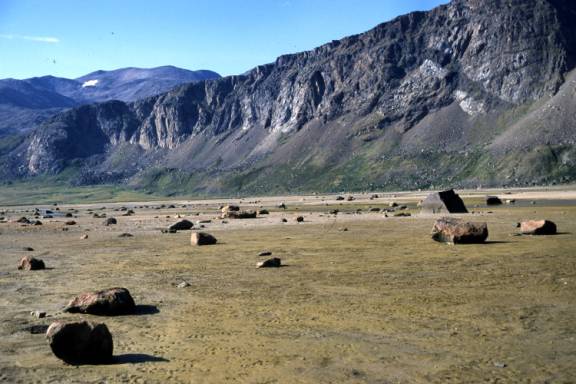
It is great to get back to the ocean side. The rise and fall of the tide presents a different landscape from the overland hiking route. Winding between mountain passes is certainly exciting as rounding each corner present a new and different landscape. But I like the calm peacefulness and quiet that seaside living offers. Rocks hidden become exposed, seals, fish, whales, all sea life large and microscopic gets sucked out by the great vacuum of waters’ retreat. Other life borrows the low tide lands, gulls pecking at stranded minnows, seaweed, snails. Me too, I’m a temporary resident of the mud flats, happily investigating as whim desires.
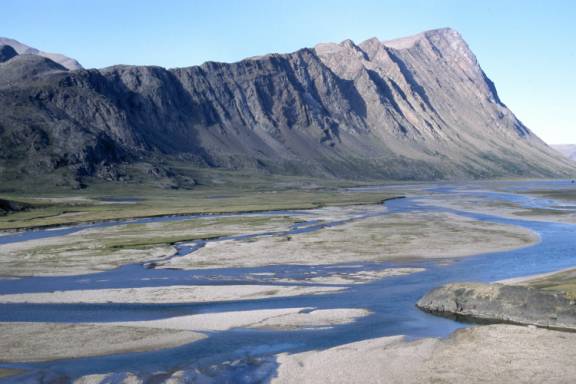
One of the first things we do is check the possibility of crossing the Komaktorvik River, in order to have a look at the north side of the fiord. Waiting for low tide, we hunt up and down the mouth of the braided outlet for pebble islands that might further divide the river into shallower streams. Despite the rivers current, there is a noticeable brackish taste – it must be leaching up and in through the porous bottom and side. Eventually, we give up on the idea of an easy crossing at the mouth, not willing to wade deeper than our knees. Days later, we walk about 4 km upstream and are able to cross at low tide.
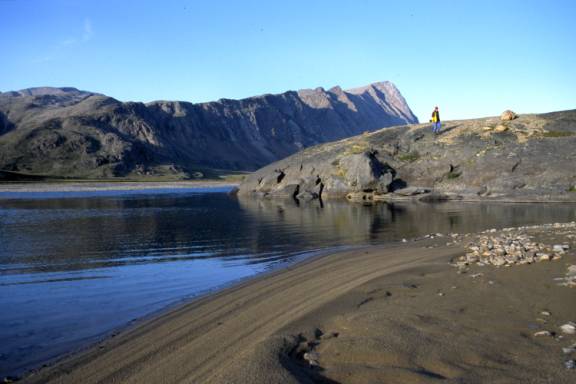
Shifting from back packing to base camp living requires a psychological re-alignment. Essentially, I have left, temporarily abandoned, all the stuff I need to survive at a place, out of sight. What if the tent blows away in a freakish gust of wind? (thinking of the Aven incident) what if a bear pilfers our food? (not happened so far but…). It’s like letting go of the grocery store and house – a security line interrupted or stretched – and we are out here on our own. I ponder this thought. However, the rational brain shoves anxieties aside with the back bone cheering at it’s no load status, Besides, it’s hard to be fearful when the weather is so great!
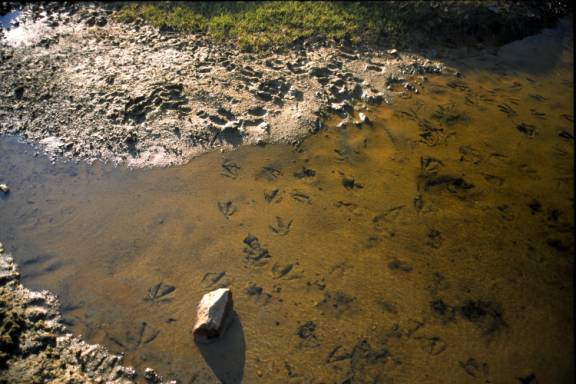
The striking difference between Torngak’s Lair and Komaktorvik is the lushness of the valley. Green stuff supports life. Piles of caribou poo, tracks on the beach, cries of sea gulls, honking of geese even the buzzing of mosquitoes tells me things are alive here. My ears shift like radar, my head swivels hopefully, looking for animals.
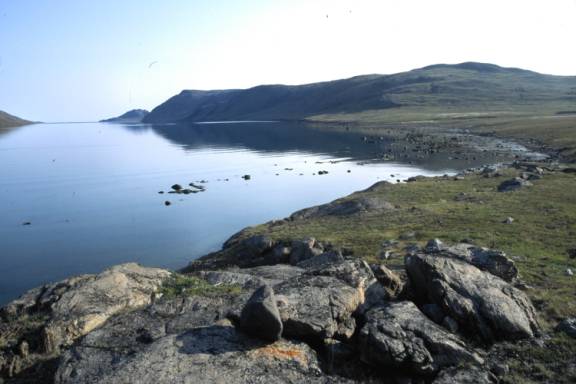
I love to explore a new place. First, nooks and crannies closest to the tent are examined. Then with larger and larger outward concentric sweeps, big brush strokes paint in odd rocks, terraces, gullies filled with shrubs. Finally, the macro picture: the rocky beach below, the distant opposite shore, the end of the valley, the outlet of the fiord. The sky becomes another plane in this room with no walls. By knowing my surroundings, it feels like home, the unfamiliar becomes known.
Minor variations are to be expected: the sky clouds, it gets dark, the tide goes in and out, the wind whips the bushes. But my brain processes these changes as allowable and doesn’t set off any alarm bells: when something unexpected shows up, my subconscious taps me on the shoulder and says ‘hey wake up, over there, something different, have a look!’. In this way, I often become aware of animals before I really ‘see’ them.
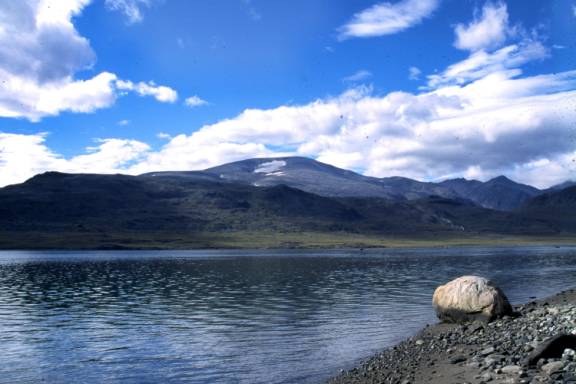
We spend hours, binoculars in hand, crouched behind rocks, looking. One day, we are lucky to see a polar bear hunt a seal. Out of sight on a terrace above the beach, it is dead calm. I notice a funny white ‘log’ drifting towards shore…suddenly it explodes, a polar bear attempts to pin a seal, sun bathing on a rock. This goes on for about 90 minutes, the bear sneaking up to different rocks, different seals. I’m amazed that all seals in the harbour don’t take alarm and swim away but they remain motionless until the last possible minute, then in one quick motion, slide off the rock and sprinting away under water. The polar bear sometimes gives chase, lunging through the shallows, his pursuit creating a momentous wake. After repeated efforts with no success, he gives up. I follow him with binoculars, as he swims across the fiord, just his white head visible, a pronounced V in the calm waters. He exits the water, shakes himself like a dog, water droplets flying from coarse white fur, before disappearing between large boulders.
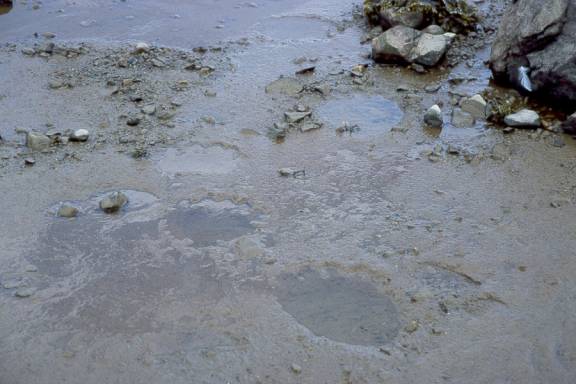
While evidence of past human habitation is apparent at many river outlets it is less obvious and sometimes unexpectedly found in what seems to me odd places. While wandering along the shore, I come across a small pile of lichen encrusted rocks, piled against a granite slope. To even the most untrained eye, it is man made. But it’s too small for a typical grave, being about 2 feet by 3 feet and the rocks are too small. Peering inside, the glow of something white reflects back. Carefully, I stick my hand through a gap between the rocks and pull out part of an old stone pipe. It’s broken in two pieces, the stem cool to the touch, soapstone perhaps, turning mossy green. We place tobacco in the bowl before returning it back to the rock nest.
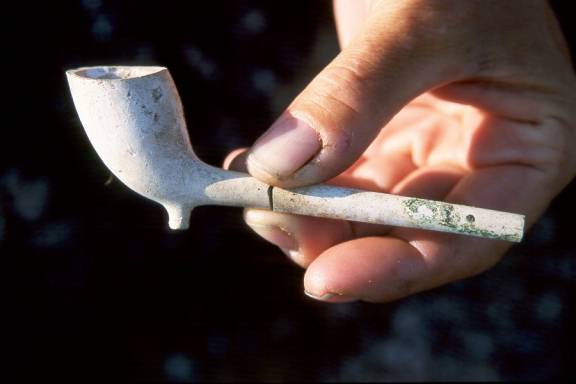
The land is subtle in its offerings. I take pleasure in the slope of a shoulder as it rolls down to the ocean, the rustling of long grasses, the pure clarity of the air. If I am lucky in my ramblings, sometimes a bone or two presents itself. Seal jaw bones are common along the coast, pointed molars razor sharp, evolved to grasp the slippery skin of darting fish. The robust front canines surprise me however – perhaps they have a defensive function.
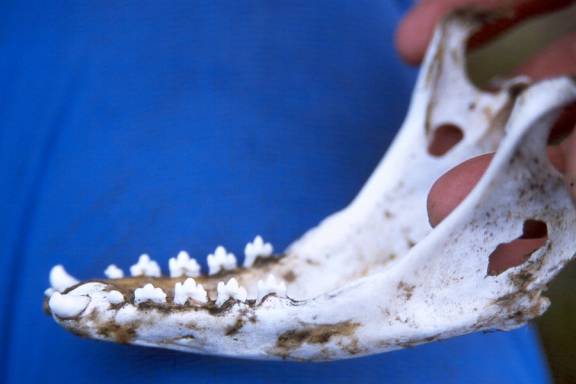
Hidden amongst the beach grasses, I stumble across a more recent carcass. Bones flung and scattered, thick and heavy limbs denuded of flesh, with only black bits around the joints remaining. At least the wriggling black fly maggots have finished their work, leaving a stench free skeleton to examine. The skull is in three pieces, upper skull case, lower jaw split in two, with pitting around the nose suggesting what was once flesh, whiskers. Polar bear? Hooded seal? Both animals are present along the coast. Again, more speculation but without a doubt, it’s eroded, rotten appearance, fascinating.
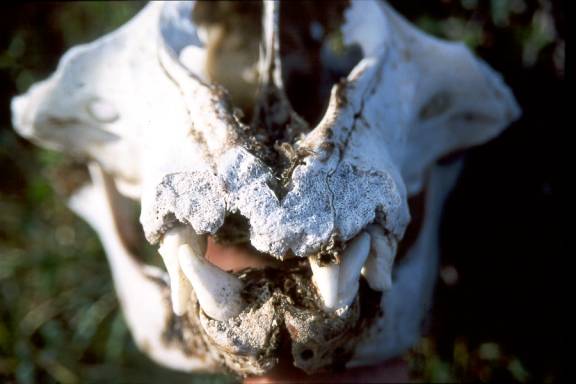
The days are getting shorter now. First out of the tent one morning (a rare thing), I stroll over to the creek, pot in hand for coffee water. While squatting down and scooping up ladlefuls, a movement below catches my eye – we see each other at same time – a wolf visually caught, now dashed away, seeking cover behind some ditch. We have heard their howling the last few nights, the pups young voices wavering as they join the pack. Later on the beach, I notice fox tracks beside the wolf tracks. And washed up on the beach sand, tiny shrimp like crusteans. Everyone knows their neighbour here and mostly, it is a peaceful time.
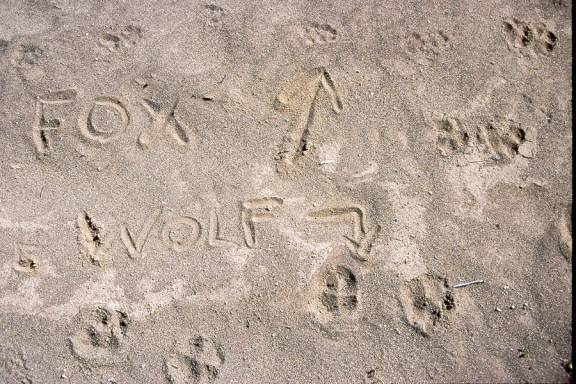
Little incentive is needed to roam over ‘just the next hill’. The walking is easy being a firm grassy slope: no hummocks, no sliding scree, no boot sucking muck. Best of all, Alfred is always keen to go. With camera or video, maybe a granola bar or beef jerky in pocket, bug dope, we set out often with no particular end point in mind. With no marked trail or path to influence our direction, the environment is considered in its entirety, instead of a list of ‘must sees’ to be checked off. Of their own accord, our feet often keep to the river valley. This time, a distant field so white beckons further exploration.
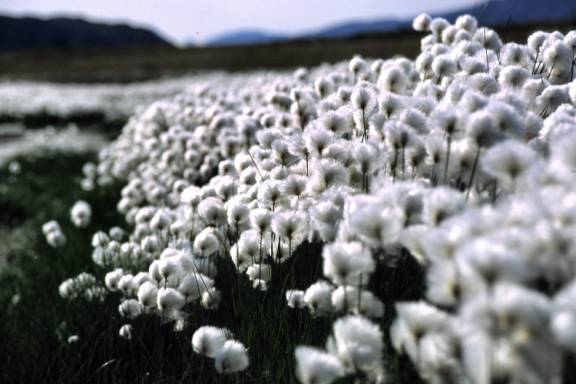
Mimicking the dead branches of a willow bush, caribou antlers rise above green grasses, the tips decorated in white down from cotton grass. Late afternoon sun backlights the translucent seed heads which are parted like hair by the wind. Closer inspection of the antlers reveals one of the prongs is well worn: Knacked by a rodent? Simply weathered? It’s the skull and antlers of a mature animal. The head up position suggests a human kill. Sawn off by a souvenier hunter? Or for some more practical use?
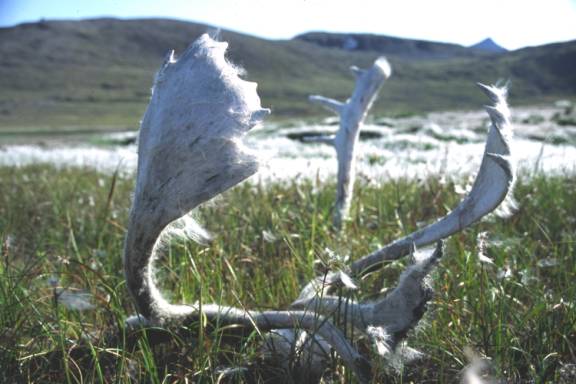
A leisurely timetable means that I can get up with the sun, inspect the start of the day and head back to the tent for a few more winks. Sometimes the early rising is rewarding when the eastern horizon is clear: the dawn starts lighting the underside of clouds a rosy pink, briefly intensifies to magenta before fading away. Sometimes, when the wind is calm, the sea mirrors the sky. When it is so still, you can hear the caribou fart on the other side of the fiord.
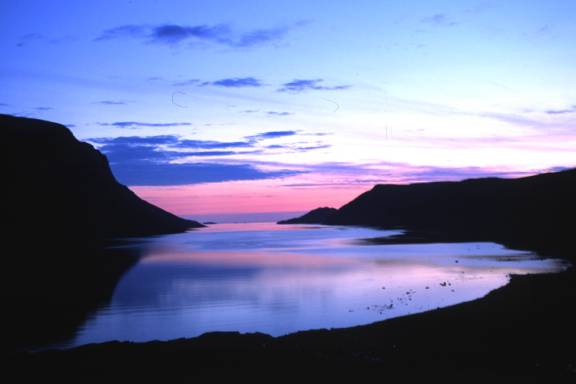
A rainy day here and there is acceptable but endless days of rain are downright depressing. Driving rain, sometime with sleet, means a tent day where long naps, chats, repairs punctuated with cups of tea, are in order. Days often start with an overcast but as the sun rises, the atmosphere warms, winds pick up and conditions change. A warm sprinkle on a sunny day simply wakens the thirst of mosquito hordes, enlivening them to renewed frenzy. Stoically, we wait out the wet, knowing it is unlikely to last for long.
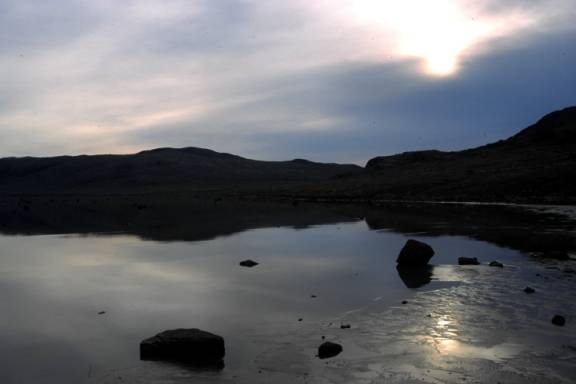
Fall is in the air. Mornings are frosty, there is a crispness to the air - a vague feeling has blown in, settling across the land. The lazy days of hot summer sun have given way to a purposefulness. Leaves change colour, caribou seem more skittish, even the rain seems harder. After a 24 hour rain, we wake to a snow dusting on the peaks. Soon it will be time for us to go home.
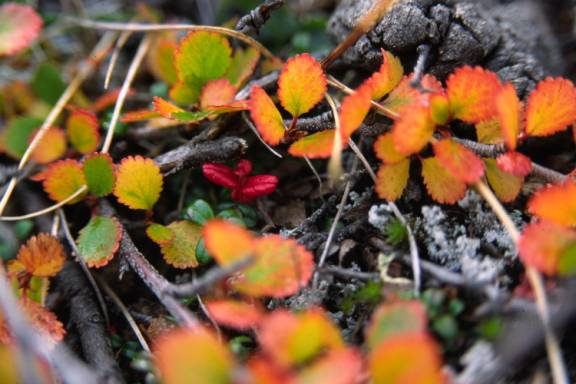
Our day walks get longer and longer. We decide to spend a few days exploring Sapogatsiak (Trout Trap on some maps) fiord, just to the south of Komaktorvik Fiord. Packing up base camp, with 3 days of food and fuel, we head out, retracing our steps towards Torngak’s Lair. I notice a smear of polar bear shit about 100 meters from our tent, just outside the alarm fence. It seems like a good time to leave.
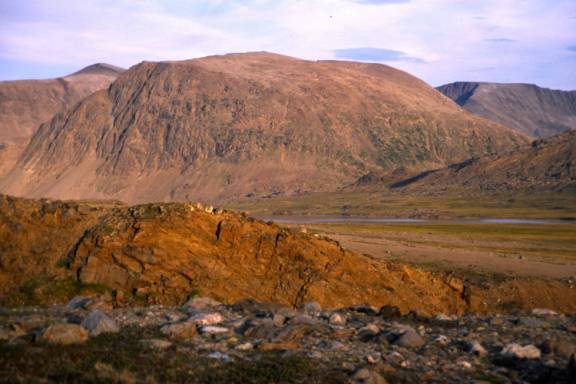
With the wind in our faces, the bugs keep away. But it’s an easterly and that almost always means fog or rain or both. For now, I enjoy the sun, the walking, the light packs! The fields of cotton grass are noticeably thinner now, having lost most of their fluff. Spread by the wind, seeds settle in the dampness of surrounding ponds, another sign of the approaching fall season. Last years snow patch, lodged deep between odd orange ridges away from the suns rays, wafts up cool air. Glacial rock rubble litters the land. A suitable tent site is set up and a smaller than normal alarm fence is erected due to the shortage of wire. Clouds build over head, rapidly changing shape. The sun disappears behind mountain peaks by 8pm, the temperature drops rapidly. I retreat to the tent, a candle warms the damp air inside.
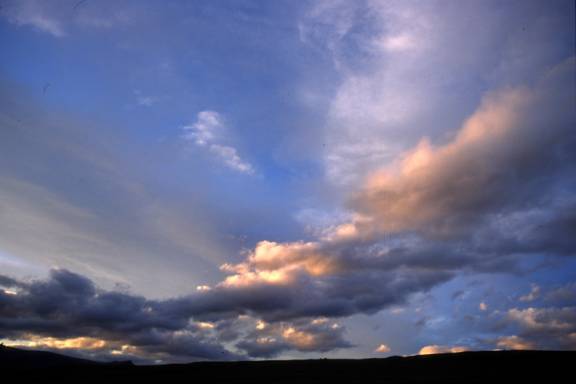
I’m woken sharply from a dreamless sleep. The overnight drizzle has stopped…at 6am, its only semi daylight. There is a sharp noise I can’t identify, by my head, just outside the tent. Alfred is still deep in sleep, the alarm doesn’t go…cautiously, I unzip the tent, open the fly and peer around to the back. And see nothing!
Curious yet cautious, I peek over the tent, standing for a better look. A red fox with black legs and white tail tip, looks guilty, caught in the act. He’s trying to pull my hiking pole out from under the tent fly. With the handle and strap in his mouth, the basket is stuck under the fly and he is yanking, trying to work it free. “Shoo!” I say...he does nothing, “get lost you!” louder this time…still no reaction, his black beady eyes fixed on me.
“This is crazy” I think, “who is the boss here??” I let out a Tarzan yell and charge towards him – this time, he takes the hint and backs off but very slowly – if so inclined, I could have kicked his butt (but since I was in bare feet and he has sharp teeth….).
He sits about 25’ away, waiting to see what I will do. By this time, Alfred is awake, head out the tent door, wondering what all the fuss is about – he is laughing at the Mexican standoff: lady in green underwear, bare feet, yelling at a fox. But he doesn’t laugh when the fox approaches the fence line (having slipped underneath it) and starts to chew on the post, there by setting off the alarm! Now, Alfred runs out but with a bear flare which he fires – the screech combined with brilliant red is finally enough to convince that persistant fellow to scram. Inspecting for damage, and seeing it is limited only to my hiking pole strap (now useless), we return back to the tent for more clothes in the dawn light and brisk wind.
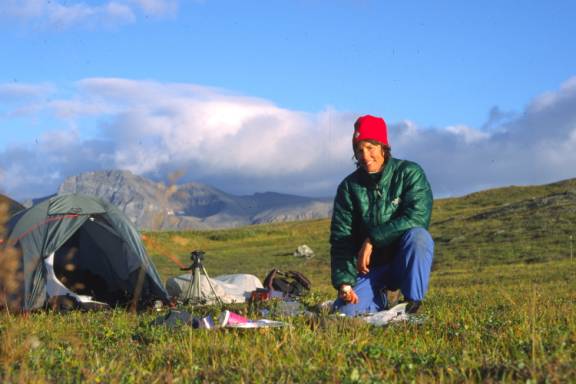
After a fast breakfast of oatmeal and ‘teabag’ coffee, we decide to leaving the tent where it is, and day hike deeper in to Sapogatsiak. It is about a one hour walk until we reach the shoreline proper. I’ve been watching the glistening waters get closer and closer, admiring the 2500’ opposite slope and as always, on the lookout for animals. Instead of something live, the first thing we find is a whole seal skeleton which has been dragged up on a terrace, about 15’ above the water, now resting on a bed of tundra grasses.
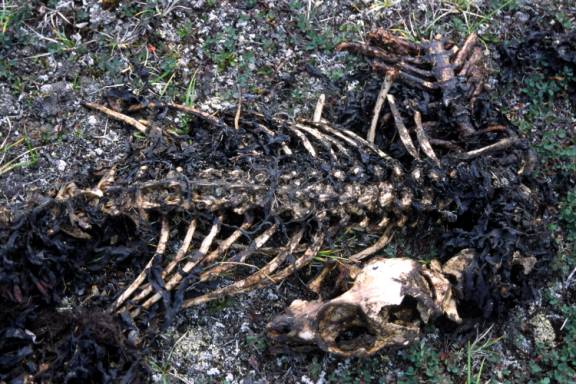
On full alert, it appears to be a fairly recent kill with sticky leftovers still clinging to the bones. This mornings’ fox may have visited here before checking out our tent. Steps away, three collapsed sod houses rest, stone walls overgrown with grass, entrances just above the high tide beach. A sleeping ledge rings the interior wall, rock mattresses for some Thule family who likely fished the productive waters of nearby creek. Calm turquoise waters and the opportunity to beach comb entice us to follow the sandy shore.
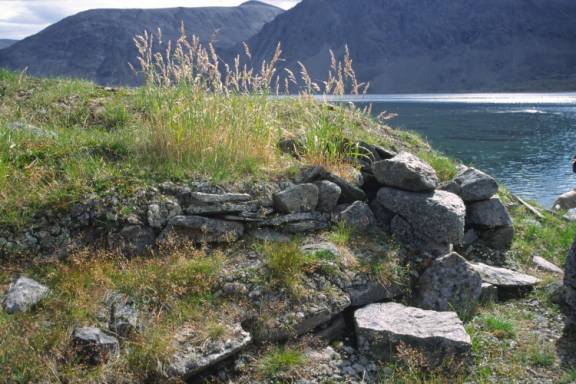
A long finger of land of juts out into the fiord, a natural path to follow. We find more tent rings, an old fox trap, some wooden stakes and more seal skeletons along the way. Who was here first is hard to say but we are the only ones here now, it’s exhilarating with only the wind to watch us. A small island guards the fiord entrance before the sea waters are pinched by increasingly steep rock slopes. I soak up the views from the end of the peninsula, standing on a small rocky knob where undoubtedly many others have stood, watched and waited. Small rock piles mark old caches or perhaps merely treasure chests for games played by children. We lunch, fantastic light of clouds and sun playing with us.
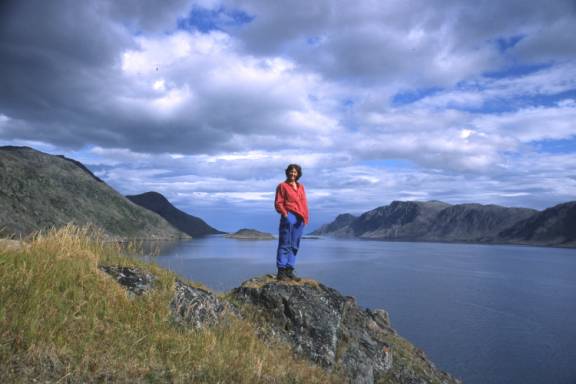
The day is getting late, we slowly turn back to camp, stopping to fish in Trout Trap Creek itself. The water is black with char, there are hundreds of fish swimming upstream in thigh deep water (well visible with polarized sunglasses), red tipped fins and silver bellies flashing in the sun. Excitedly, Alfred hooks a fish on the first cast but it slips the hook as he reels it on to the shore. I cast the line, get three hits but again, can’t manage to land the fish. Then, my line breaks taking the lure with it. I’m irked, how can it be so hard here in the river of plenty? Alfred takes over but not before the line breaks again and the second lure is lost. With our last lure, much to our great satisfaction, Alfred gets lucky, hooking and landing what appears to be the biggest char of the summer.
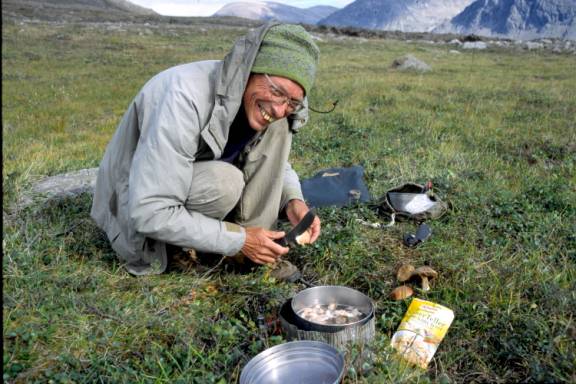
With great glee, we hurry back to camp, our appetites whetted by the long walk and fresh air. Quickly Alfred guts the fish, it’s a female full of bright orange eggs…like caviar, the eggs are slightly salty, jumping like popcorn in a hot oiled pan. Supplemented with wild boletus mushrooms and a soup mix, the fish stew makes for a satisfying meal.
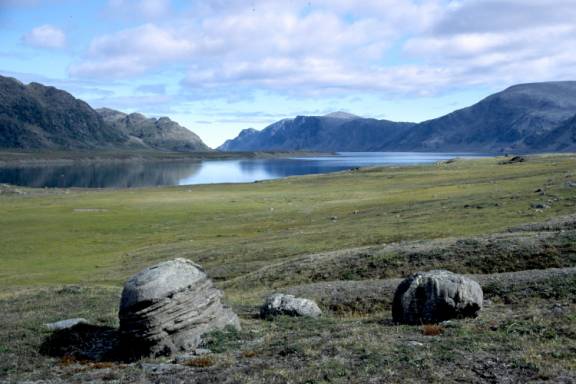
The next morning, we explore the south shore. It’s an easy crossing the outflowing creek, unlike the Komaktorvik River – someone placed those rock hoping stones so carefully spaced and deliberate. A waterfall spills across polished rock, down from its high mountain source, audible last night at our campsite, a distance of 1 km away. Three rocks, weirdly weathered and eroded into lumps, sit like cookie dough on a green baking sheet. The south shore proves to be just as popular as the north shore in times past: more tent rings, heavily traversed caribou trails, and more seal skeletons. The concentration of seal skeletons is truly impressive, we refer to this place as ‘skeleton coast’ there afterwards.
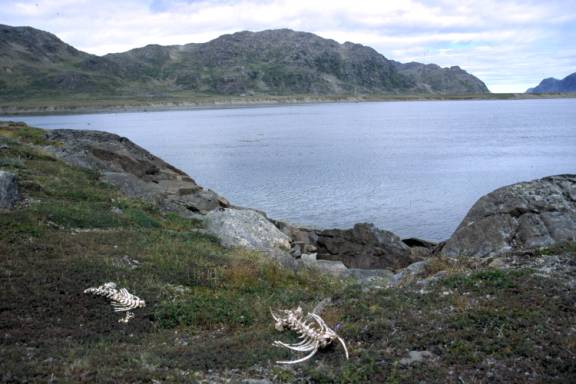
Eventually, we run out of shore to follow as steep headland rises directly from the sea. Inland, a valley with multiple creeks rises steeply from the same shoreline…we are too lazy to climb, content to retrace our steps towards camp. A peregrine falcon perches on a low tide rock, screeching from a safe distance, black chin strap well visible. His partner perches nearby, on another rock, this one still surrounded by water. A small flock of black ducks bob in the bay, rising and falling to the rhythm of the oceans swell. A fat bee clings to the stalk of a tall yellow flower, anchored against the wind, gathering fall nectar.
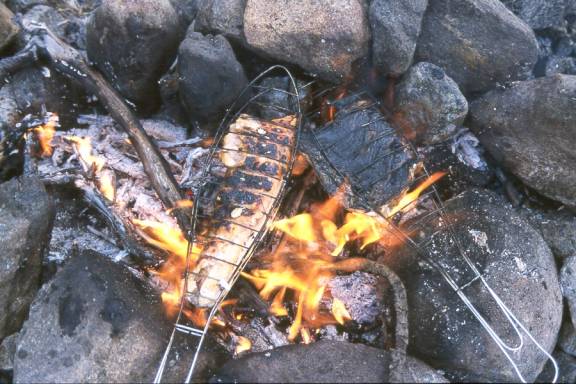
It’s our last night here before we head back to the main base camp. We fish again, this time quickly successful with our last remaining lure, hooking the fish through the dorsal fin. A raging fire of dry willow twigs quickly burns down to coals, fish fillets sizzle, laying across small green sticks. The crisp black skin a treat after days of mushy camp food, the fatty pink flesh adds welcome calories to our lean diet. Tired but happy, we head in for the night.
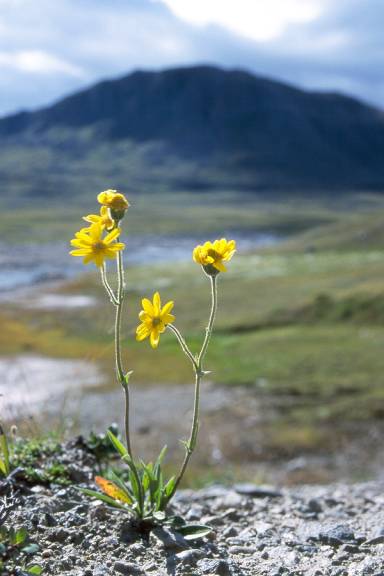
I’m deep in sleep when the alarm blares, jolting me awake, Alfred already scrambling for the tent zipper. It’s 5am – an eerie predawn light caused by a mix of high overcast cloud and chilly sea fog barely illuminates the closest hump of hill – nothing seems to move except the bite of the wind – the tent fly flaps in the wind, we crouch motionless, scanning the surroundings for anything that moves…..nothing. Gun in hand, Alfred carefully walks the perimeter of the fence – I am the eyes, looking and straining for a sudden rush in any direction – a bear in the worst case - but can see less than shadows. Silently, Alfred repairs the wire. Several places have been torn, evidence of a large animal in hasty retreat. Bear? Caribou? Wolf? A drizzle sets in, we return to the tent for a snooze.
By 10am and with no further alarm ado, we are up and restless to roll out, heading back to the base camp at Komaktorvik. The weather has worsened, with heavy rain and strong wind gusts. We decide to postpone our start until some weather improvement. With sufficient food for another 24 hours, there is no rush.
Yet within two hours, the weather breaks – quickly the tent is taken down, gear stowed, backpacks loaded. A cool west wind in our face keeps the bugs away, we head off over wet tundra grasses. We are strong now at the end of the summer, the packs feel light. It’s a short 5 or 6 hour walk back to camp. Short bursts of rain drizzle keep our cameras firmly inside their water proof bags. Sometimes it’s liberating to take no pictures and just enjoy. A peregrine or goshawk flies over us, hunting low over the hills, only the dark silhouette seen from below, tapered wings and tail, a lethal flying killer. Ponds with quiet geese, pretend to be rocks, in an effort to hide from predators. Mergansers and black ducks mingle, equally quiet.
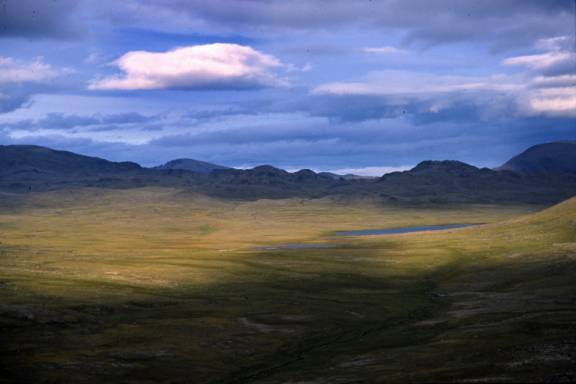
Just as we climb the last hill, at the last corner where the views will disappear behind us, the sun breaks through. It’s so gorgeous, the golden light late day shadows across distant slopes, hurriedly I uncover the buried camera in an effort to capture the fleeting moment, shooting at random and hoping for the best. It’s over as quickly as it came: the clouds close up and the land becomes an uninspiring uniform grey. We turn our backs and continue the last kilometers into camp.
Happily, when we arrive nothing appears to have been disturbed by the wildlife: no chew marks, no gnawing, no hauling and pulling away. Quickly the wet tent is re-erected and dinner is started. Today is Alfred’s 49th birthday so I cook his favourite meal: salami and macaroni. We toast with the last polar storm drink, a gut warming concoction of maple syrup, full fat milk powder and dash of rye whisky, celebrating his birthday, a successful summer and hopefully, to our helicopter pick up tomorrow. It’s a cold light at the end of the day, the sun hidden behind a band of dark storm clouds. One or two stars peak out, we settle back, hoping for northern lights.
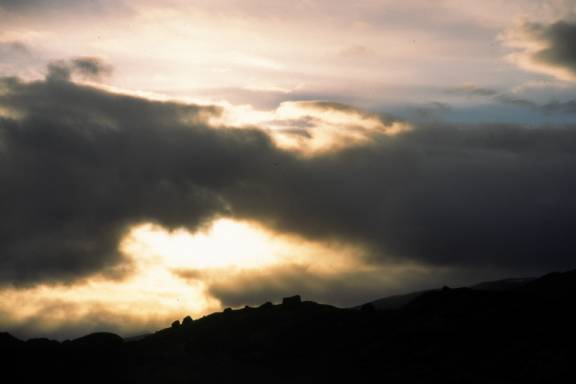
In typical unsettled fall conditions, the weather next morning has taken a turn for the worse with heavy rain gusts, low sea fog and temperatures about 5C. Our departure pick up is scheduled for 2pm. The helicopter should have left Goose Bay at 10am but we both know in our guts it is an unlikely event. We content ourselves with the last of the coffee and milk powder, potato flakes and salami for breakfast. By noon, it has altered from rain to hail pellets back to rain, with a rainbow and sun hit teasers in between.
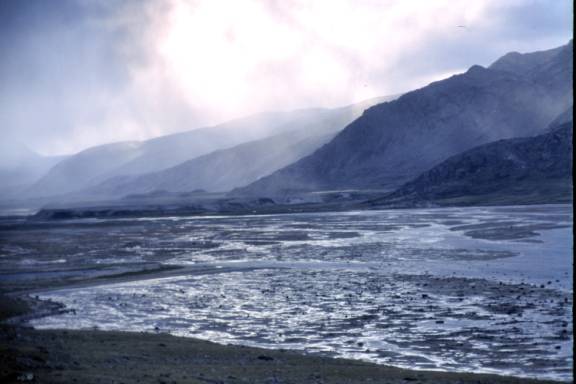
Tundra colours deepen in conjunction with the downward temperatures. Blue berry bushes flame orange, prostrate crowberry bushes are tipped scarlet. Like a black bear gorging before winter freeze, I can’t stop picking the purple and sometimes frozen berries. Yesterday I tasted a fat intensely sweet raspberry that consisted of a singe kernel.
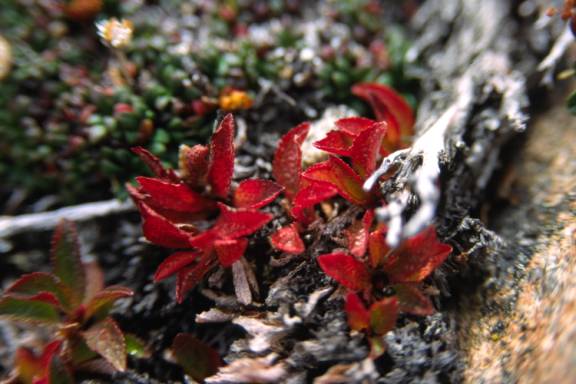
By 4pm, it’s confirmed that our pick up is delayed at least another day mostly due to high winds. Our food stores are low but as our energy output today has been modest, a dried soup thickened with some dried pasta crumbs that the bowl and satisfies the guts is good enough. Fingers and toes are warmed by a quick climb up the ridge behind camp, distant views out the fiord mouth of a passing iceberg, ethereal. Another day comes to the end, nothing momentous or epic has happened, just living on the land and letting things unfold as they may.
Breakfast reveals similar weather to yesterday. Grey gusty winds howl and shake the tent but at least the rain has stopped (for now). Another cold night with more snow dusting mountain peaks, the winds of Ungava Bay relentlessly pushing across the Torngats, bringing fall storms. Hot water boils on the camp stove, there are now three tea bags left: save or splurge? We splurge, each brewing tea with our own bag. Decadence enjoyed with the smallest things!
Suddenly then noise of rotary blades interrupts the calm…its our pick up, Darren has beat the odds, fighting turbulence, pelting rain mixed with snow, piloting the helicopter with skill typical for those who fly this precarious coast. Quickly we load, stowing gear in the rear compartment, in the back seat and where ever it will fit. Instantly airborne – I feel giddy, the ground severed beneath my feet, my connection broken, yanked from a land where time, my summer, has stood still.
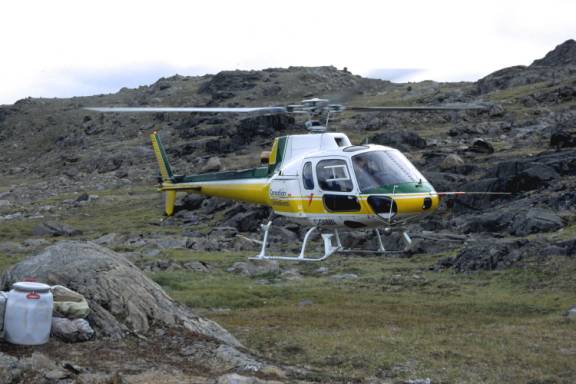
It feels like the clock is going backwards as we fly south, high over places which are now more than names on a map: Komaktorvik, the lush valley of Sapogatsiak, secret cracks of Torngak’s Lair, mist shrouded nameless landlocked peaks, the blue foaming waters of Nachvak fiord. In Ivitak, as the white dot of a polar bear lopes away from the noise of the chopper, I wonder ‘is that our bear?’.
Towering rain clouds obscure our inland route, Darren veers out to follow the rugged coast, in search of safe passage. It feels like a desperate prison escape, a snatch and grab, we are running for our lives, the wrath of Torngak bites at our heels.
My system feels discombobulated with change of pace, the frenzy, the efficiency of movement and speed of decision making. It’s a rude re-entry to the world and I can do little more than mutely blink, processing the forgotten but what is really old and familiar.
The two hour return flight includes a refueling stop before the final disgorge into the town of Nain. Still reeling, I hear myself talking but can’t quite connect. That night, I lay awake in the hotel bed, surrounded by walls for the first time in weeks, suffocated by hot, dry, heated air. The hum of mechanical noise has replaced the flapping of the tent fly. I’ve barely been gone and already I miss my wild tundra home.
